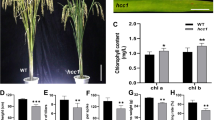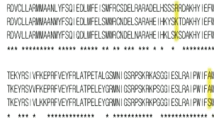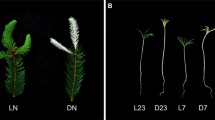Abstract
It was recently proposed that pheophytinase (PPH) is a key protein that mediates chlorophyll (Chl) breakdown in leaves. To study the role and regulation of PPH on Chl breakdown of peel in harvested ‘Yali’ pear (Pyrus bretschneideri Rehd. cv. ‘Yali’) fruit, the partial sequence of PbPPH was obtained from the NCBI database, and the alignment results revealed that the amino acid sequence of PbPPH shared great similarity to PPHs of Chinese flowering cabbage (Brassica rapa var. parachinensis) and Arabidopsis (Arabidopsis thaliana), indicating that these proteins have similar functions. Ethephon treatment significantly increased ethylene production of pear fruit and accelerated the proceeding of Chl breakdown. Conversely, 1-methylcyclopropene (1-MCP) treatment decreased ethylene production and delayed Chl breakdown. PbPPH expression was closely related to the process of Chl breakdown and was correlated with the expression of Chl degradation-associated genes such as pheide a oxygenase and stay-green 1. The chlorophyllase 1 expression level was well maintained by 1-MCP treatment, whereas red Chl catabolite reductase expression was inhibited by 1-MCP. Further analysis indicated that the gene expression levels of four ethylene receptors were stimulated by ethephon and suppressed by 1-MCP treatment and that these changes were strongly correlated with Chl breakdown and similar to the expression pattern of PbPPH. These results suggest that PPH is one of the enzymes responsible for the ethylene-mediated Chl degradation pathway of peel in harvested ‘Yali’ pear.





Similar content being viewed by others
References
Amir-Shapira D, Goldschmidtn EE, Altman A (1987) Chlorophyll catabolism in senescing plant tissues: in vivo breakdown intermediates suggest different degradative pathways for citrus fruit and parsley leaves. Proc Natl Acad Sci USA 84:1901–1905
Barry CS, McQuinn RP, Chung MY, Besuden A, Giovannoni JJ (2008) Amino acid substitutions in homologs of the STAY-GREEN protein are responsible for the green-flesh and chlorophyll retainer mutations of tomato and pepper. Plant Physiol 147:179–187
Büchert AM, Civello PM, Martínez GA (2011a) Chlorophyllase versus pheophytinase as candidates for chlorophyll dephytilation during senescence of broccoli. J Plant Physiol 168:337–343
Büchert AM, Civello PM, Martínez GA (2011b) Effect of hot air, UV-C, white light and modified atmosphere treatments on expression of chlorophyll degrading genes in postharvest broccoli (Brassica oleracea L.) florets. Sci Hortic 127:214–219
Cao S, Yang Z, Zheng Y (2012) Effect of 1-methylcyclopene on senescence and quality maintenance of green bell pepper fruit during storage at 20 °C. Postharvest Biol Technol 70:1–6
Chen YF, Etheridge N, Schaller GE (2005) Ethylene signal transduction. Ann Bot 95:901–915
Cheng Y, Dong Y, Yan H, Ge W, Shen C, Guan J, Liu L, Zhang Y (2012) Effects of 1-MCP on chlorophyll degradation pathway-associated genes expression and chloroplast ultrastructure during the peel yellowing of Chinese pear fruits in storage. Food Chem 135:415–422
Chervin C, Deluc L (2010) Ethylene signalling receptors and transcription factors over the grape berry development: gene expression profiling. Vitis 49:129–136
Ella L, Zion A, Nehemia A, Amnon L (2003) Effect of the ethylene action inhibitor 1-methylcyclopropene on parsley leaf senescence and ethylene biosynthesis. Postharvest Biol Technol 30:67–74
Fan X, Mattheis JP (2000) Yellowing of broccoli in storage is reduced by 1-methylcyclopropene. HortScience 35:885–887
Gasic K, Hernandez A, Korban SS (2004) RNA extraction from different apple tissues rich in polyphenols and polysaccharides for cDNA library construction. Plant Mol Biol Rep 22:437a–437g
Gómez-Lobato ME, Hasperué JH, Civello PM, Chaves AR, Martínez GA (2012) Effect of 1-MCP on the expression of chlorophyll degrading genes during senescence of broccoli (Brassica oleracea L.). Sci Hortic 144:208–211
Gong Y, Mattheis JP (2003) Effect of ethylene and 1-methylcyclopropene on chlorophyll catabolism of broccoli florets. Plant Growth Regul 40:33–38
Guo H, Ecker JR (2004) The ethylene signaling pathway: new insights. Curr Opin Plant Biol 7:40–49
Harpaz-Saad S, Azoulay T, Arazi T, Ben-Yaakov E, Mett A, Shiboleth YM, Hörtensteiner S, Gidoni D, Gal-On A, Goldschmidt EE, Eyal Y (2007) Chlorophyllase is a rate-limiting enzyme in chlorophyll catabolism and is posttranslationally regulated. Plant Cell 19:1007–1022
Hodges DM, Forney CF (2000) The effects of ethylene, depressed oxygen and elevated carbon dioxide on antioxidant profiles of senescing spinach leaves. J Exp Bot 51:645–655
Hörtensteiner S (2006) Chlorophyll degradation during senescence. Annu Rev Plant Biol 57:55–77
Hörtensteiner S, Kräutler B (2011) Chlorophyll breakdown in higher plant. Biochim Biophys Acta 1807:977–988
Hörtensteiner S, Wüthrich KL, Matile P, Ongania KH, Kräutler B (1998) The key step in chlorophyll breakdown in higher plants. Cleavage of pheophorbide a macrocycle by a monooxygenase. J Biol Chem 273:15335–15339
Hua J, Meyerowitz EM (1998) Ethylene responses are negatively regulated by a receptor gene family in Arabidopsis thaliana. Cell 94:261–271
Hurr BM, Huber DJ, Vallejos CE, Talcott ST (2009) Developmentally dependent responses of detached cucumber (Cucumis sativus L.) fruit to exogenous ethylene. Postharvest Biol Tec 52:207–215
Jacob-Wilk D, Holland D, Goldschmidt EE, Riov J, Eyal Y (1999) Chlorophyll breakdown by chlorophyllase: isolation and functional expression of the Chlase1 gene from ethylene-treated Citrus fruit and its regulation during development. Plant J 20:653–661
Jiang H, Li M, Liang N, Yan H, Wei Y, Xu X, Liu J, Xu Z, Chen F, Wu G (2007) Molecular cloning and function analysis of the stay green gene in rice. Plant J 52:197–209
John-Karuppiah KJ, Burns JK (2010) Degreening behavior in ‘Fallglo’ and ‘Lee × Orlando’ is correlated with differential expression of ethylene signaling and biosynthesis genes. Postharvest Biol Technol 58:185–193
Kao CH, Yang SF (1983) Role of ethylene in the senescence of detached rice leaves. Plant Physiol 73:881–885
Kieber JJ (1997) The ethylene signal transduction pathway in Arabidopsis. J Exp Bot 48:211–218
Klee HJ (2004) Ethylene signal transduction. Moving beyond Arabidopsis. Plant Physiol 135:660–667
Kräutler B (2008) Chlorophyll breakdown and chlorophyll catabolites in leaves and fruit. Photochem Photobiol Sci 7:1114–1120
Ma QH, Wang XM (2003) Characterization of an ethylene receptor homologue from wheat and its expression during leaf senescence. J Exp Bot 54:1489–1490
Matile P, Schellenberg M (1996) The cleavage of phaeophorbide a is located in the envelope of barley gerontoplasts. Plant Physiol Biochem 34:55–59
Matile P, Hörtensteiner S, Thomas H, Kräutler B (1996) Chlorophyll breakdown in senescent leaves. Plant Physiol 112:1403–1409
Matile P, Hörtensteiner S, Thomas H (1999) Chlorophyll degradation. Annu Rev Plant Physiol Plant Mol Biol 50:67–95
McCollum G, Maul P (2007) 1-MCP inhibits degreening but stimulates respiration and ethylene biosynthesis in grapefruit. HortScience 42:120–124
Narumi T, Aida R, Ohmiya A, Satoh S (2005) Transformation of chrysanthemum with mutated ethylene receptor genes: mDG-ERS1 transgenes conferring reduced ethylene sensitivity and characterization of the transformants. Postharvest Biol Technol 37:101–110
Nukui N, Ezura H, Minamisawa K (2004) Transgenic Lotus japonicus with an ethylene receptor gene Cm-ERS1/H70A enhances formation of infection threads and nodule primordia. Plant Cell Physiol 45:427–435
Oberhuber M, Berghold J, Breuker K, Hörtensteiner S, Kräutler B (2003) Breakdown of chlorophyll: a nonenzymatic reaction accounts for the formation of the colorless “nonfluorescent” chlorophyll catabolites. Proc Natl Acad Sci USA 100:6910–6915
Park SY, Yu JW, Park JS, Li J, Yoo SC, Lee NY, Lee SK, Jeong SW, Seo HS, Koh HJ, Jeon JS, Park YI, Paek NC (2007) The senescence-induced staygreen protein regulates chlorophyll degradation. Plant Cell 19:1649–1664
Pruzǔinská A, Tanner G, Anders I, Roca M, Hörtensteiner S (2003) Chlorophyll breakdown: pheophorbide a oxygenase is a rieske-type iron-sulfur protein, encoded by the accelerated cell death 1 gene. Proc Natl Acad Sci USA 100:15259–15264
Pruzǔinská A, Tanner G, Aubry S, Anders I, Moser S, Müller T, Ongani K, Kräutler B, Young J, Liljegren SJ, Hörtensteiner S (2005) Chlorophyll breakdown in senescent Arabidopsis leaves. Characterization of chlorophyll catabolites and of chlorophyll catabolic enzymes involved in the degreening reaction. Plant Physiol 139:52–63
Pruzǔinská A, Anders I, Aubry S, Schenk N, Tapernoux-Lüthi E, Müller T, Kräutler B, Hörtensteiner S (2007) In vivo participation of red chlorophyll catabolite reductase in chlorophyll breakdown. Plant Cell 19:369–387
Purvis AC, Barmore CR (1981) Involvement of ethylene in chlorophyll degradation in peel of citrus fruits. Plant Physiol 68:854–856
Rodoni S, Mühlecker W, Anderl M, Kräutler B, Moser D, Thomas H, Matile P, Hörtensteiner S (1997) Chlorophyll breakdown in senescent chloroplasts (cleavage of pheophorbide a in two enzymic steps). Plant Physiol 115:669–676
Sato Y, Morita R, Nishimura M, Yamaguchi H, Kusaba M (2007) Mendel’s green cotyledon gene encodes a positive regulator of the chlorophyll-degrading pathway. Proc Natl Acad Sci USA 104:14169–14174
Schaller GE (2012) Ethylene and the regulation of plant development. BMC Biol 10:9
Schelbert S, Aubry S, Burla B, Agne B, Kessler F, Krupinska K, Hörtensteiner S (2009) Pheophytin pheophorbide hydrolase (pheophytinase) is involved in chlorophyll breakdown during leaf senescence in Arabidopsis. Plant Cell 21:767–785
Schenk N, Schelbert S, Kanwischer M, Goldschmidt EE, Dömann P, Hötensteiner S (2007) The chlorophyllases AtCLH1 and AtCLH2 are not essential for senescence-related chlorophyll breakdown in Arabidopsis thaliana. FEBS Lett 581:5517–5525
Serek M, Sisler EC, Reid MS (1994) Novel gaseous ethylene binding inhibitor prevents ethylene effects in potted flowering plants. J Am Soc Hortic Sci 119:1230–1233
Shemer TA, Harpaz-Saad S, Belausov E, Lovat N, Krokhin O, Spicer V, Standing KG, Goldschmidt EE, Eyal Y (2008) Citrus chlorophyllase dynamics at ethylene-induced fruit color-break: a study of chlorophyllase expression, posttranslational processing kinetics, and in situ intracellular localization. Plant Physiol 148:108–118
Suzuki T, Kunieda T, Murai F, Morioka S, Shioi Y (2005) Mg-dechelation activity in radish cotyledons with artificial and native substrates, Mg-chlorophyllin a and chlorophyllide a. Plant Physiol Biochem 43:459–464
Tsuchiya T, Ohta H, Okawa K, Iwamatsu A, Shimada H, Masuda T, Takamiya K (1999) Cloning of chlorophyllase, the key enzyme in chlorophyll degradation: finding a lipase motif and the induction by methyl jasmonate. Proc Natl Acad Sci USA 96:15362–15367
Wang W, Hall AE, O’Malley R, Bleecker AB (2003) Canonical histidine kinase activity of the transmitter domain of the ETR1 ethylene receptor from Arabidopsis is not required for signal transmission. Proc Natl Acad Sci USA 100:352–357
Watkins CB (2006) The use of 1-methylcyclopropene (1-MCP) on fruits and vegetables. Biotechnol Adv 24:389–409
Wüthrich KL, Bovet L, Hunziker PE, Donnison IS, Hörtensteiner S (2000) Molecular cloning, functional expression and characterisation of RCC reductase involved in chlorophyll catabolism. Plant J 21:189–198
Yang TF, Gonzalez-Carranza ZH, Maunders MJ, Roberts JA (2008) Ethylene and the regulation of senescence processes in transgenic Nicotiana sylvestris plants. Ann Bot 101:301–310
Yang X, Song J, Campbell-Palmer L, Fillmore S, Zhang Z (2013) Effect of ethylene and 1-MCP on expression of genes involved in ethylene biosynthesis and perception during ripening of apple fruit. Postharvest Biol Technol 78:55–66
Zhang X, Zhang Z, Li J, Wu L, Guo J, Ouyang L, Xia Y, Huang X, Pang X (2011) Correlation of leaf senescence and gene expression/activities of chlorophyll degradation enzymes in harvested Chinese flowering cabbage (Brassica rapa var. parachinensis). J Plant Physiol 168:2081–2087
Zhao XC, Qu X, Mathews DE, Schaller GE (2002) Effect of ethylene pathway mutations upon expression of the ethylene receptor ETR1 from Arabidopsis. Plant Physiol 130:1983–1991
Acknowledgments
This research was supported by the Earmarked Fund for China Agriculture Research System (CARS-29-20).
Author information
Authors and Affiliations
Corresponding author
Rights and permissions
About this article
Cite this article
Cheng, Y., Guan, J. Involvement of Pheophytinase in Ethylene-Mediated Chlorophyll Degradation in the Peel of Harvested ‘Yali’ Pear. J Plant Growth Regul 33, 364–372 (2014). https://doi.org/10.1007/s00344-013-9383-z
Received:
Accepted:
Published:
Issue Date:
DOI: https://doi.org/10.1007/s00344-013-9383-z




